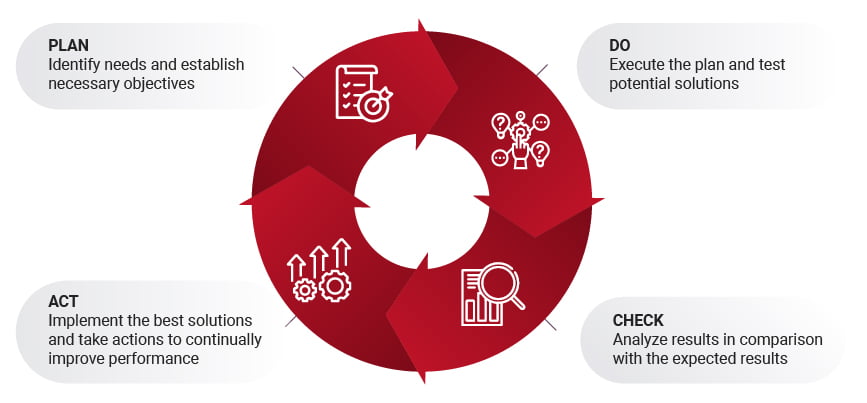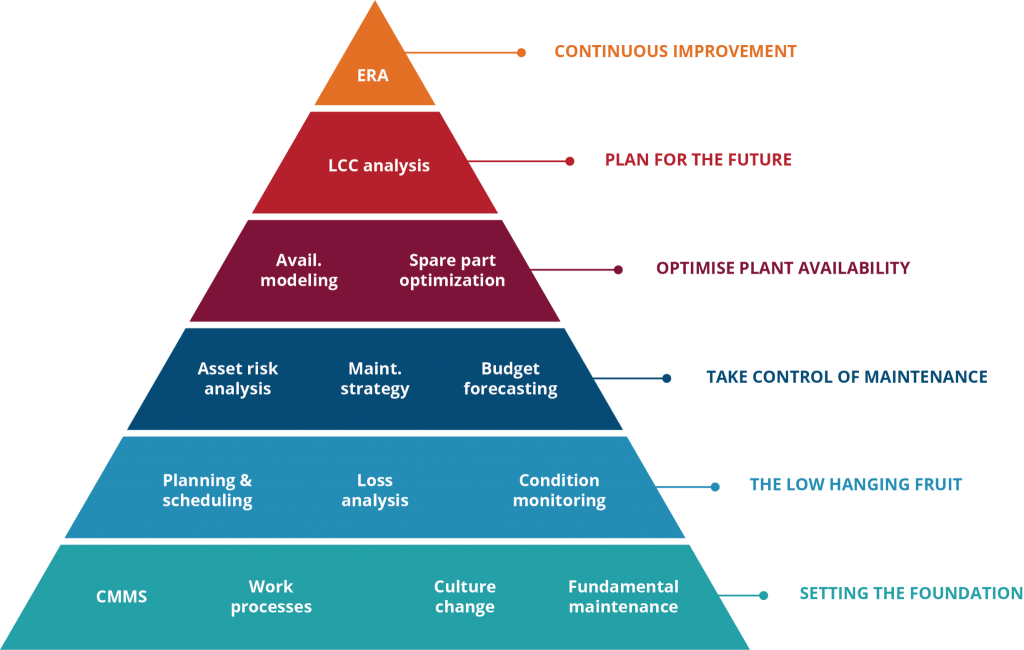In this article, we compare the most recent version of ISO 55000, published in 2024, with the previous version, published in 2014.
The first thing to note is that “ISO 55000”, as it is often referred to, is, in fact, a series of documents.
These include:
- ISO 55000:2024 – Vocabulary, overview and principles, and
- ISO 55001:2024 – Asset management — Asset management system — Requirements
- ISO 55002:2018 – Asset management — Management systems — Guidelines for the application of ISO 55001
- ISO 55010:2019 – Asset management — Guidance on the alignment of financial and non-financial functions in asset management
- ISO 55012:2024 – Asset management — Guidance on people involvement and competence
- ISO 55013:2024 – Asset management — Guidance on the management of data assets
ISO 55000:2024, as its title suggests, outlines some high-level principles relating to Asset Management, but more importantly, contains the definitions of all the key terms used in ISO 55001:2024.
ISO 55001:2024 is the requirements document that specifies the criteria to be met if an organisation seeks to align with, or be certified as conforming to, the requirements of the standard.
The other four documents provide guidance regarding the application of ISO 55001 in a variety of areas. It is important to note that these four documents provide guidance only – it is not necessary to follow that guidance in order to align or conform with the requirements of ISO 55001:2014, although it may be advisable to do so.
In this article, we will only be comparing the 2024 version of ISO 55000 (that is, ISO 55000:2024) with its predecessor ISO 55000:2014. We compare ISO 55001:2024 with its predecessor ISO 55001:2014 in a separate article, and will also discuss the guidance documents in further articles.
Key Differences between ISO 55000:2024 and ISO 55000:2014
The first, and most obvious difference between the current and previous versions of ISO 55000 is their size. ISO 55000:2024 is five pages shorter than ISO 55000:2014, at 22 pages long compared to 27 pages previously. While this may not seem like much of a difference, when you consider that 7 of those pages are either cover pages, blank pages, the table of contents and the index, and a further 2 pages are a Foreword and Introduction, the proportional difference in technical content is quite large. The primary reason for this is a significant reduction in the size of the section describing the principles, benefits and key concepts relating to Asset Management. In ISO 55000:2014, this section was 9 pages long. In ISO 55000:2024 it is 3 pages long. When you examine the content that has been removed from the 2014 version to produce the 2024 version, the reasoning behind this is clear. Much of the content that has been removed is either:
- Covered in ISO 55001:2024 as a requirement, or
- Provides context and guidance for the application of ISO 55001:2024, and is therefore better covered in ISO 55002:2018 or one of the other guidance documents
The remaining content is more concise, and the document is the better for it.
Fundamentals vs Principles, Outcomes and Benefits
In terms of content, an important difference between ISO 55000:2024 and ISO 55000:2014 relates to what was, in the 2014 version, called “fundamentals”. ISO 55000:2014 describes four fundamentals of Asset Management, being:
- Value
- Alignment
- Leadership, and
- Assurance
In ISO 55000:2024, the first three of these have been relabelled as “principles”. Assurance has now been labelled as being an “outcome” together with two additional outcomes, being:
- Adaptability, and
- Sustainability
Perhaps it is just a matter of semantics, but my personal preference was for Assurance – that is the process of checking that planned actions are performed, and that, in performing those actions, the desired outcomes were realised – to be considered as a “fundamental” element of any management system, not just an Asset Management System. In that way, you could consider the previous four “fundamentals” as being key elements of the Plan-Do-Check-Act cycle, with
- “Value” being the target that you are trying to achieve,
- “Alignment” being the process of establishing plans and procedures for delivering that value in a manner that creates vertical and horizontal alignment across the organisation (Plan),
- “Leadership” being the process of ensuring that planned actions are performed in accordance with the documented procedures (Do), and
- “Assurance” being the process of monitoring compliance with procedures and the achievement of desired outcomes and instituting corrective actions to address non-conformances and performance gaps (Check and Act).

Nevertheless, I can understand that Assurance, in addition to being a process, can also be interpreted as being an outcome of the above Plan-Do-Check-Act cycle, if implemented correctly. Perhaps the English language (and other languages) require separate words for Assurance (the process) and Assurance (the outcome)?
The outcome of Adaptability is newly added in the 2024 version of ISO 55000 and reflects the reality of doing business in the 21st century, where management systems need to be able to respond to (often rapid) changes in their internal and external operating context and meet ever-changing stakeholder needs and expectations.
Sustainability as an outcome is also new to the 2024 version of ISO 55000, emphasising the need for long-term thinking and the need to embrace the non-financial aspects of value, balancing economic outcomes with environmental and social outcomes. This also reflects the reality faced by many organisations, where consideration of environmental and social outcomes has moved beyond simply assuring compliance with regulatory requirements towards a deeper understanding of the longer-term value that improving performance in these areas can bring.
10 potential areas of benefit are listed in ISO 55000:2024, one more than was listed in ISO 55000:2014. Three additional benefits are listed:
- “Greater stakeholder satisfaction and confidence”,
- “Improved co-ordination and communication”, and
- “Increased value from innovation”.
Two benefits listed in ISO 55000:2014 have been removed:
- “Improved products and services” has been removed, which is fair, as this is perhaps more suitably considered as a benefit from a Quality Management System, rather than an Asset Management System.
- “Improved organisational sustainability” has also been removed as a benefit, this now being considered as an “outcome” as discussed above.
The distinction between benefits and outcomes appears to be somewhat arbitrary, in my view, but it is not worth getting hung up on the semantics of the difference between these two. The fact remains that effective Asset Management will assist organisations in asset-intensive industries to realise greater value from their assets.
Definitions
The really important part, for most people, of ISO 55000, is not the discussion of principles and benefits of Asset Management, but the definitions contained in this document, as it is these definitions which greatly shape the requirements specifications contained in ISO 55001.
ISO 55000:2024 follows a similar structure for definitions as was used in ISO 55000:2014, that is it groups the definitions under the following headings:
- Terms relating to assets
- Terms relating to asset management
- Terms relating to asset management system
The one big difference is that the section containing “General” definitions no longer exists in the 2024 version of the document, with the definitions that used to be contained in that section now distributed amongst the other sections.
While perhaps logical, this structure remains a problem when searching the document for the definition of a specific term, at least when using a printed copy of the standard, as it first requires you to decide which of these categories the term belongs to.
Furthermore, in ISO 55000:2014, the definitions contained in each section were listed in alphabetical order. This is no longer the case in ISO 55000:2024, with definitions in each section being listed in no logical order that I could determine – at least in the English language version of the standard.
A simple listing of all definitions in alphabetical order would, in my opinion, be much more useful. Having said that, the electronic version of the document is searchable – though a search for some of the more common terms throws up multiple matches – a search for the term “objective” for example, yields 46 results – so it may take a while to find the specific definition you are looking for.
Most of the key definitions remain unchanged. For example, the definition of an asset is still the same, as is the definition of asset management.
Other definitions have changed – some more important than others.
In my view, the most important of the changes is the updated definition for a Strategic Asset Management Plan (SAMP). This is now defined in ISO 55000:2024 as being:
- Documented information that contains and aligns asset management policy, objectives, strategies and approaches for developing and managing the asset portfolio and the asset management system.
This is distinctively different from the definition in ISO 55000:2014 which was:
- Documented information that specifies how organizational objectives are to be converted into asset management objectives, the approach for developing asset management plans, and the role of the asset management system in supporting achievement of the asset management objectives
The new definition is, in my view, much clearer regarding the role that the SAMP is intended to play in the Asset Management System. It is now quite clear that the SAMP is intended to be a bridging document that brings together and aligns all of the key elements of the Asset Management System. This is a real benefit, as, in our experience, the intended purpose of the SAMP has always been unclear and has led to significant confusion amongst those seeking to align or certify against the standard regarding its contents.
At the same time the updated definition is much less specific regarding its contents. The requirements regarding the contents of the SAMP are now more explicitly covered in ISO 5501:2024, which is totally appropriate – more on this in a future article.
There are two minor changes regarding the definition of the SAMP that those organisations that are certified as conforming to the requirements of ISO 55001:2014 and who wish to transition to conformance with the requirements of ISO 55001:2024 should note. These are:
- ISO 55000:2024 no longer explicitly permits the SAMP to be called by another name (e.g. an Asset Management Strategy), as was permitted by ISO 55000:2014. This may or may not be an issue if you already have a document that conforms with the requirements relating to a SAMP but have called it something other than a SAMP. It will depend on the extent to which Conformance Assessment Bodies, in assessing conformance with ISO 55000:2024 will be strict in applying this definition. Note, however, that ISO 55001:2024 does permit the contents of the SAMP to be spread across multiple documents – so it is likely that a lenient approach to the naming of these documents will be taken.
- ISO 55000:2024 also now requires the Asset Management Policy to be contained within the SAMP. This was not previously the case, and many organisations that we have worked with do not include their Asset Management Policy within their SAMP. In practice, however, including the AM Policy within the SAMP is a relatively minor fix.
There are several other, less important changes to definitions. For example:
- Asset life is now defined as “period from asset ideation to asset end of life”, rather than “period from asset creation to asset end of life.
- Life Cycle is now “stages of an asset during its life” rather than “stages involved in the management of an asset”
- A stakeholder is now clarified as being equivalent to an “interested party”
There are also some additional definitions in the new version of the standard, including:
- Life cycle management – applying asset management over the life cycle of assets
- Object – anything perceivable or conceivable
- Data – facts about an object
- Information – meaningful result of organizing and processing data
- Knowledge – understanding of facts, information and principles acquired through experience, research or education
- Level of service – parameters, or combination of parameters, which reflect social, political, environmental and economic outcomes that an organization delivers. Note that this not the same definition as that given for an objective.
- Opportunity – circumstance or set of circumstances that can be exploited to improve performance, exceed original objectives and/or intended results, pursue additional objectives, or achieve continual improvement
- Sustainability – state of the global system, including environmental, social and economic aspects, in which the needs of the present are met without compromising the ability of future generations to meet their own needs
- Value – results from satisfying needs and expectations
Most of these are fairly straightforward and obvious, in my view. One additional definition that is important, however is as follows:
- Framework – structure of processes and specifications designed to support the accomplishment of a specific task
Many organisations that we have worked with have established documents that they have called an “Asset Management Framework” or “Asset Management Manual” that outlines the key processes involved in managing their assets, and how these relate to each other. This is generally a high-level document, not specifically aimed at the accomplishment of a specific task, so not, strictly speaking, a “framework” as defined by ISO 55000:2024. However, I do not foresee any issues in continuing to call this document a “framework” if that works for you, as ISO 55001:2024 (which we will discuss in the next article in this series) does not consider a “framework” to be a specific document and contains no specific requirements relating to a document titled a “framework”. It may be worth considering, however, given the changes to the definition of a Strategic Asset Management Plan noted above, whether your “Asset Management Framework” or “Asset Management Manual” should be included in, or linked to, your SAMP.


